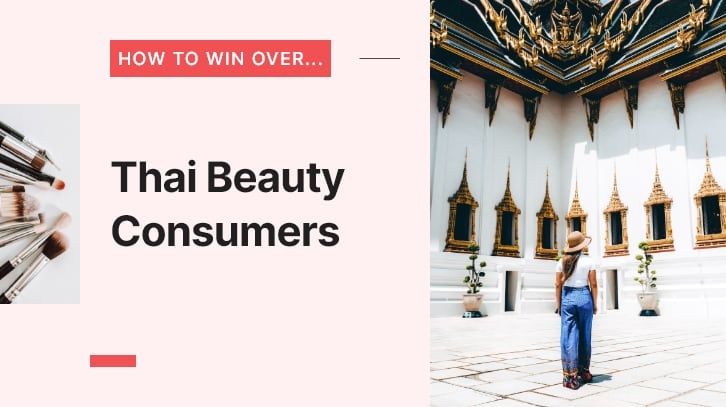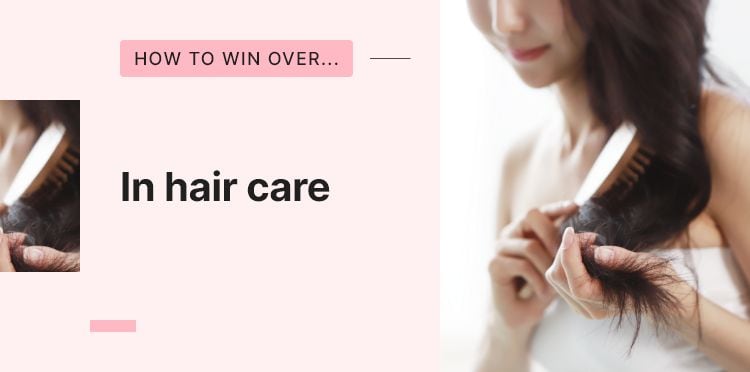Thailand's beauty culture is deeply rooted in its rich traditions and a profound appreciation for holistic wellness as well as aesthetics.
Traditionally, it emphasises herbal remedies and natural ingredients, such as turmeric and tamarind, to enhance beauty and maintain skin health. Thai massages, or Nuad Thai, take a comprehensive approach to beauty that transcends mere physical appearance and hold great significance in the realm of beauty and wellness
While ancient traditions and rituals are widely respected, the Thai beauty consumer is known for their openness and willingness to try new innovations in the ever-evolving beauty industry. Their curiosity and enthusiasm have created a culture of experimentation, resulting in a dynamic market.
“They are not afraid to try. I guess that’s what makes Thailand interesting. It’s the Asian country where companies always want to put the new products and use it almost like a proxy market,” said Isaree (Start) Sismey, senior director at MMR Research Worldwide.
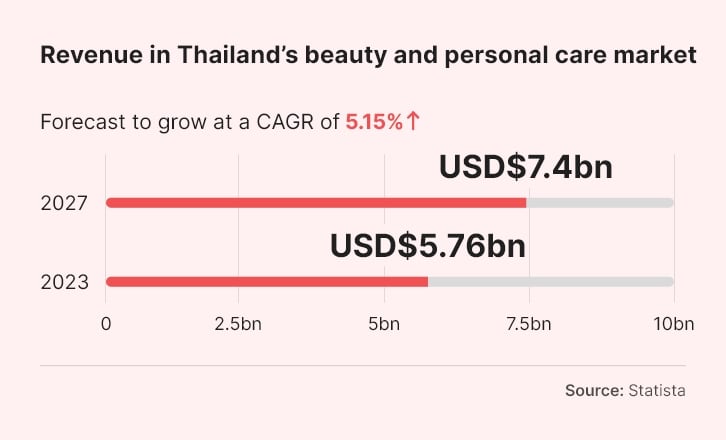
“The Thai population is very daring. When it comes to colour, like to explore. You will see people using green, blue and purples. These bolder colours are more common here than in Malaysia or Singapore,” said Kat Wei, regional director of business development, Karmart.
This seamless integration of heritage and modernity has created a vibrant and diverse beauty landscape, attracting both locals and international beauty enthusiasts.
With lockdowns, social distancing measures, and economic uncertainties, the Thai beauty market experienced major challenges after the COVID-19 outbreak.
Post-pandemic, Thailand’s beauty sector is bouncing back vigorously. Not only have locals come down with ‘revenge shopping’ fever, but tourists are also returning to one of the most visited countries in the world, bringing enticing opportunities for cosmetic companies.
‘Lips are a must’: Beauty priorities of Thai consumers
Karmart is a Thai cosmetic company that was established in 1997 and has since become prominent player in the beauty industry. The company’s portfolio spans 15 beauty and personal care brands, including Cathy Doll, Skynlab, and Browit.
The firm produces over 1,000 SKUs ranging skin care, colour cosmetics, fragrances, and personal care. Despite the upheavals and shifts brought about by the pandemic, makeup remains the biggest category for the company.
“For sure it’s makeup. In Thailand, lips are a must for the ladies. When you walk into a 7-Eleven, which are everywhere in Thailand, you will see a lot – a lot – of lip products. I think that’s quite special,” said Wei.
“We are quite strong in skin care. Many of our brands offers products under skin care, but sales of makeup are significantly higher than skin care – more than 10% difference.”
While make-up generally saw a decline in the past couple of years because of COVID-19, Karmart saw a huge spike thanks to its dedicated eye make-up brand Browit.
“Browit launched in 2017, starting with just brow products. Precisely because there was a focus on the eyes during COVID, we saw huge growth,” said Wei.
Overall, the firm is seeing growth across all make-up categories, but make-up remains the strongest.
Speaking to CosmeticsDesign-Asia, Wei said that although Thai authorities have long lifted mask mandates, a majority of locals still choose to wear them.
“If you walk into the mall, you can obviously tell those that are not wearing masks are foreigners, locals have really gotten used to it.”
And this has not deterred Thai beauty consumers from wearing a full face of makeup underneath their masks.
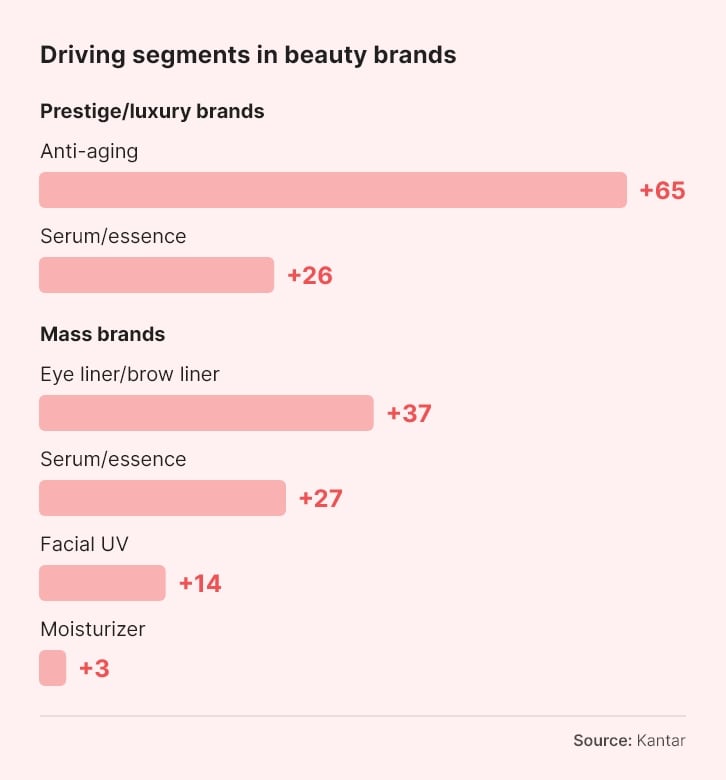
“Through the last three years of COVID, most of the brands, ours included, have adapted. For example, we have launched quite a few lip products that stay on even with a mask on,” said Wei.
That being said, like fellow Asian markets, skin care is becoming an important category. Over the pandemic, there has been a notable shift towards an interest in skin care.
However, Sismey highlighted that companies must understand that Thai beauty consumers have a unique perspective on skin care.
“In China, Korea, and Japan, they emphasise that your inner skin health. The belief is that your skin needs to be health so it can shine and be pretty. But in Thailand, they want to see an immediate effect. If this can improve my skin within seven days, that’s too long,” she said.
To cater to Thai beauty consumers, brands offer light cosmetic effects with their skin care products such as colour correcting tints or optical blurring effects.
“What you’ve got is a very appearance conscious consumer,” said Sismey, who has worked with multinational beauty and personal care companies such as Unilever.
“Thai people like brightening and glowing effects – and we’re not talking about cosmetics yet, just skin care – basic skin care in Thailand will be tinted with optical effects. Thai people won’t mind if they need to use several products. More is fine as long as it has immediate effect and looks quite natural.”
This demand for instantaneous effects is compounded by two major factors in Thailand. The first is the pervasiveness and accessibility to aesthetic treatments.
“Anti-ageing used to start after 25 but now it’s starting as early as 20. People are getting vitamin C injections at that age. I think the adoption [of aesthetic treatments] has intensified. They have a really open mind about things like Botox, so they want that in their skin care so they can just go for Botox every six months instead of every three months,” said Sismey.
“A superior experience isn’t just efficacy. It’s about elements of the early sensory experience signalling a benefit to their hair or skin – a cooling sensation or a formula transformation that shows something is happening.”
The second is the popularity of beautifying mobile applications that allow consumers to edit their appearance with filters.
Not only is this heightening their demands for skin care, but these apps are also putting pressure on the makeup market.
“In the past, you’ll need five different lipsticks for different looks. Now you just need one and you can change the colour on the app if you want,” said Sismey.
Be it makeup or skin care, the biggest priority among Thai beauty consumers is still whitening or brightening.
“It’s a default demand. I’ve spoken to people about what they want, and they don’t mention the brightening effect because they just think every product will have it. So they feel like they don’t even need to talk about it.” Sismey said.
“I don’t think the trend of diversity we see in Thailand is not on the same level in the beauty industry. It’s not something they have adopted. I guess it’s because they have different priorities; the ultimate goal is to look the best as possible.”
More often than not, the definition of beauty in Thailand these days are informed by Korean standards of beauty.
“Honestly, [the beauty standards] just changed from Japan to Korea, but it’s the same kind of stereotype – natural, fair, big eyes, plump face, bright coloured lips.”
Online vs offline: It’s all about experience
With the return of shoppers and eager tourists, there has been a strong uptick in the brick-and-mortar sector. In March, Thai retail conglomerate Central Group reported that its 2022 earnings grew by 28%, while profits increased by 51%
“Our earnings for 2022 have recovered well – on par with 2019 earnings prior to COVID-19, with positive factors from the continuing recovery of the Thai economy. People's spending improved at the end of the year and there are increasing numbers of tourists in addition to government and private sector support measures to spur spending,” said the firm’s CFO Naparat Sriwanvit.
While more Thai consumers are shopping on their smartphones like any other modern consumer, physical retail remains the primary revenue driver for Karmart.
The company has made online investments that have resulted in significant growth of around 15% to 20%. However, brick-and-mortar retail is still the firm’s biggest contributor by a country mile.
“We operate our own online flagship stores and official websites We also do TikTok, Facebook Live which have been successful. I think within one or two hours, if it gives us THB2m to THB5m (USD57,586 to USD143,905), we consider that successful.
“But [online] still not our main revenue source Yes, it has been growing and the growth is significant, but it still can’t be compared with offline. It makes up a single-digit contribution for us,” Wei said.
As such, the company focuses its marketing efforts on offline events. Sometimes, its offline events happen as often as once a month.
Wei added that the strength of the firm’s offline business has also been boosted by the return of tourists as well. “With tourism reopening up, we see our offline growing significantly.”
When it comes to perception, a large swarth of Thai beauty consumers see e-commerce platforms as a channel for promotions and deals. They are returning to physical stores for the promise of an experience, said Sirinar Puppachat, Mintel beauty and personal care research analyst, Mintel.
“They still enjoy shopping, that’s an important aspect of the Thai consumer. The consumer shops for beauty everywhere and every channel plays a different role. They go to marketplaces like Lazada or Shopee for deals, but they go into stores for the experiences and seeing the product in person.”
Thailand’s beauty retail industry was undergoing an omnichannel transformation to meet the evolving needs and expectations of consumers. Puppachat highlighted the development of King Power’s offline-to-online (O2O) beauty and lifestyle store Firster.
“The whole store is about offering a seamless O2O experience for the consumer. You can order products online then go pick it up and check it in store before bringing it home.”
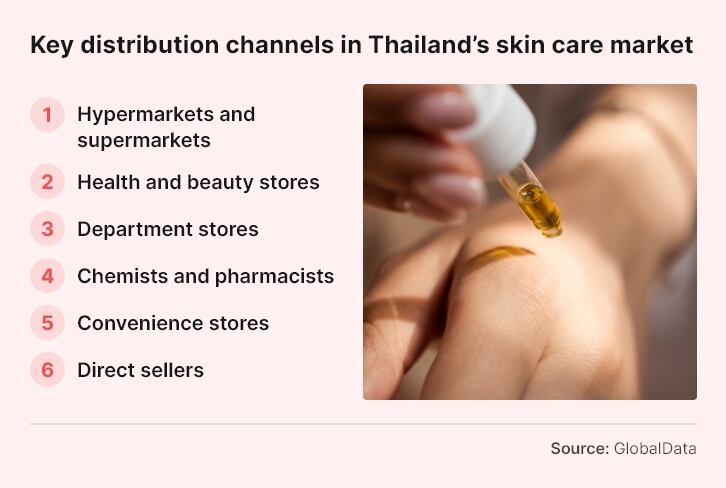
That being said, the online market is rich ground for foreign brands looking to vie for a share of the Thai beauty market.
“We’ve been exporting for at least seven to eight years. We originally started selling on the online channels like Lazada, Shopee and various other platforms,” said Peter Bosevski, global marketing and sales manager or G&M Cosmetics.
G&M Cosmetics is an Australian manufacturer of brands such as Australian Creams and P’URE Papayacare.
“More than two-thirds of [Thailand’s] population has a smartphone. Whatever the demographic, there’s someone with a mobile phone in hand and they are shopping online. That’s going to grow even further,” said Bosevski.
Bosevski also highlighted the growing influence of LINE Shopping, the social commerce arm of the LINE mobile application.
“There are opportunities in the online shopping space. The model is there, people have access with their smartphones, and beauty is the third most popular category behind electronics and fashion. That’s telling us there’s high demand in the online space.”
Naturals, wellness, premiumisation: Thailand’s beauty opportunities
With the success of its export business to Thailand, G&M has begun expanding into brick-and-mortar retail stores, such as Tops Club, which is owned by Central Retail.
In addition to Australian Creams, the company has expanded P’URE Papayacare into the market.
“The brand is 100% vegan and 100% natural. It’s gentle and safe to use on your skin. That section of consumer is fast growing at the moment – that niche is no longer a niche. We’ve got a product with the elements consumers want,” said Bosevski.
G&M Cosmetics was recently on the ground in Thailand for the launch of P’URE Papayacare and found that local consumers resonated with the brand.
“We had a two-week event promoting the brand and we had a great result. For South East Asia in general, it’s definitely about the natural ingredients. It’s about the safe, gentle, clean, and green concept. In the eyes of the Thai shopper, Australia is definitely up there with Japanese and Korean skin care in terms of that safety and cleanliness.”
During its two-week run, the company found that its P’URE Papayacare range of baby products were more popular with Thai consumers than its facial cosmetic range.
“We had two categories, the facial range and baby products. The baby range did even better. I think there are half a million babies born in Thailand every year, which is why there’s higher demand for baby products.”
Thailand is one of G&M’s top five priority markets for its by its growing middle class with higher discretionary incomes.
“The middle class is growing rapidly, and the Thai consumer is spending money on beauty products. Even through during COVID when there was the economy was low, people were still spending on beauty products,” said Bosevski.
This is driving brands to offer more premium products to consumers. For instance, Cathy Doll recently expanded into the fragrance category.
“The segment we’ve been trying to hit since late 2020 is fragrances so we will definitely be exploring more in that area. It can be perfumes, diffusers, essential oils… We see this as a pretty significant segment we should hit on, especially since Karmart is already providing all sorts of products from head to toe,” said Wei.
The rising interest in fragrance could be linked to the COVID-19 pandemic. As people navigated the challenges and restrictions imposed by the pandemic, they sought solace and comfort through scent. The role of fragrance in self-care and wellness has been heighted as a result of this.
Fragrance has an opportunity to grow even more in Thailand on the back of the wellness trend.
“Any product regarding wellness is a big opportunity in the beauty market even Thailand as well. We see that 67% of Thai consumers link stress with beauty. They feel that when they feel stressed, it actually has a negative impact on their appearance,” said Puppachat.
She added that wellness is seen as a key opportunity, particular for Thailand, which has the resources, such as traditional herbal ingredients to play an important role in this sector.
Thailand was one of the first key Asian markets for skin care brand Dr. Barbara Sturm. Today, the brand has six touchpoints in Bangkok alone.
“It’s a very impulsive but high potential market. And contrary to popular belief, the average consumer there is actually very sophisticated when it comes to skin care. They are very open to trying a lot of new things,” said Nancy Wong, APAC trade marketing manager for Dr Barbara Sturm.
One of the major challenges the brand experiences is marrying education and entertainment to engage with Thai consumers.
“Education is important [in Thailand]; they are willing to pay more for skin care, but they have to understand why. At our price points, you don’t want them to misunderstand. So, you have to explain why they should pay more, but in a way they can digest quickly. You’re going to lose them with a 25-minute video,” said Wong.
[More insights from MINTEL on Thailand's beauty market]
T-Beauty: The next power player?
As the beauty manufacturing hub of SEA, Thailand is known for its expertise in formulating and producing high-quality beauty products. Furthermore, thanks to partnerships between private enterprises, academia and government agencies, Thailand is fertile ground for ground-breaking innovation.
Local players like Karmart believe that with its manufacturing expertise and budding R&D landscape, Thailand is positioned as a compelling contender as the next beauty leader.
“We think that the Thai cosmetics industry is going to become the next leader over the next 10 years. Over the past 10 years, we’ve been dominated by the Korean wave, but we’ve seen a lot of the K-beauty players backing out recently. This is giving rise to opportunities for Thai companies,” said Wei.
She added that Thai consumers’ experimental attitudes towards beauty makes it more likely for Thailand to become a “striking point” for the birth of new trends.
Markets like Vietnam, Cambodia, Myanmar and Laos already look up to Thai popular culture similarly to how many Asian markets look up to K-pop, Wei pointed out.
Thailand’s influence on beauty is slowly extending beyond the SEA region, especially with the influence of Lisa, a member of K-pop group BLACKPINK who is Thai.
Puppachat said: “Thai beauty products are actually quite popular among the neighbouring countries. Countries like Philippines and Vietnam take up quite a lot after the Thai trends. I think that the Thai beauty market may be the next powerhouse, or at least I hope so in the region that it can be the next K-beauty.”
Thailand's burgeoning middle class, beauty-conscious society and thriving tourism industry make it an enticing market for beauty and personal care products. With its dynamic consumer base and increasing demand for innovative beauty solutions, the opportunities for growth and success in the Thai market are boundless.


